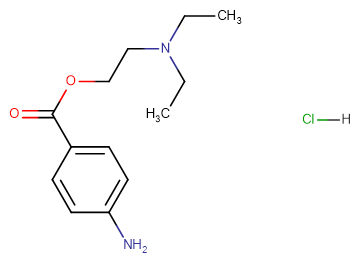
Procaine hydrochloride
CAS No. 51-05-8
Procaine hydrochloride( Novocaine )
Catalog No. M14757 CAS No. 51-05-8
A local anesthetic of the ester type that has a slow onset and a short duration of action. It is mainly used for infiltration anesthesia, peripheral nerve block, and spinal block.
Purity : >98% (HPLC)
 COA
COA
 Datasheet
Datasheet
 HNMR
HNMR
 HPLC
HPLC
 MSDS
MSDS
 Handing Instructions
Handing Instructions
| Size | Price / USD | Stock | Quantity |
| 500MG | 38 | In Stock |


|
| 1G | 45 | In Stock |


|
Biological Information
-
Product NameProcaine hydrochloride
-
NoteResearch use only, not for human use.
-
Brief DescriptionA local anesthetic of the ester type that has a slow onset and a short duration of action. It is mainly used for infiltration anesthesia, peripheral nerve block, and spinal block.
-
DescriptionA local anesthetic of the ester type that has a slow onset and a short duration of action. It is mainly used for infiltration anesthesia, peripheral nerve block, and spinal block.(In Vitro):Procaine hydrochloride (0.01-100 microM) inhibited the 5-HT3 receptor-mediated inward current in the whole-cell patch clamp recording. Procaine appears to produce a competitive inhibition on 5-HT3 receptors with a KD of 1.7 microM. Procaine is a DNA-demethylating agent that produces a 40% reduction in 5-methylcytosine DNA content as determined by high-performance capillary electrophoresis or total DNA enzyme digestion. Procaine can also demethylate densely hypermethylated CpG islands. Procaine also has growth-inhibitory effects in these cancer cells, causing mitotic arrest. Procaine functions as an excitant of limbic system cells, and that procaine alters synaptic transmission in some, but not all, output pathways from the amygdale.
-
In VitroProcaine hydrochloride (0.01-100 microM) inhibited the 5-HT3 receptor-mediated inward current in the whole-cell patch clamp recording. Procaine appears to produce a competitive inhibition on 5-HT3 receptors with a KD of 1.7 microM. Procaine is a DNA-demethylating agent that produces a 40% reduction in 5-methylcytosine DNA content as determined by high-performance capillary electrophoresis or total DNA enzyme digestion. Procaine can also demethylate densely hypermethylated CpG islands. Procaine also has growth-inhibitory effects in these cancer cells, causing mitotic arrest. Procaine functions as an excitant of limbic system cells, and that procaine alters synaptic transmission in some, but not all, output pathways from the amygdale.
-
In Vivo——
-
SynonymsNovocaine
-
PathwayEndocrinology/Hormones
-
Target5-HT Receptor
-
Recptor5-HT3| nAChR| NMDA receptor| Sodium channel
-
Research AreaNeurological Disease
-
Indication——
Chemical Information
-
CAS Number51-05-8
-
Formula Weight272.77
-
Molecular FormulaC13H20N2O2·HCl
-
Purity>98% (HPLC)
-
SolubilityWater: 55 mg/mL (201.63 mM); DMSO: 55 mg/mL (201.63 mM)
-
SMILESO=C(OCCN(CC)CC)C1=CC=C(N)C=C1.[H]Cl
-
Chemical NameBenzoic acid, 4-amino-, 2-(diethylamino)ethyl ester, monohydrochloride
Shipping & Storage Information
-
Storage(-20℃)
-
ShippingWith Ice Pack
-
Stability≥ 2 years
Reference
1. Fan P, Weight FF. Neuropharmacology. 1994 Dec;33(12):1573-9.
molnova catalog



related products
-
glucosylvitexin
Glucosylvitexin inhibits TPO activity.
-
Tryptamine
Tryptamine is a monoamine alkaloid found in plants, fungi, and animals. It contains an indole ring structure, and is structurally similar to the amino acid tryptophan, from which it derives its name.
-
Pizotifen Malate
Pizotifen malate is a highly selective 5-HT receptor blocking agent, which is a benzocycloheptane based drug.



 Cart
Cart
 sales@molnova.com
sales@molnova.com


